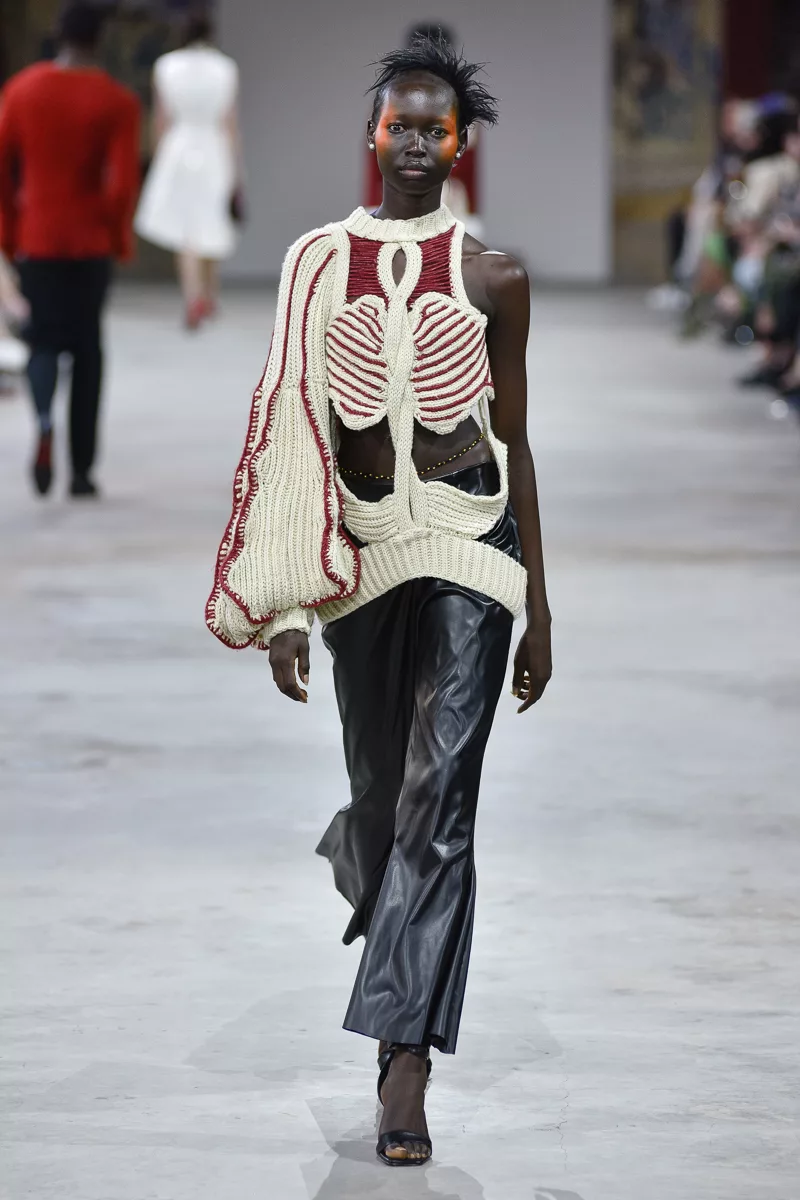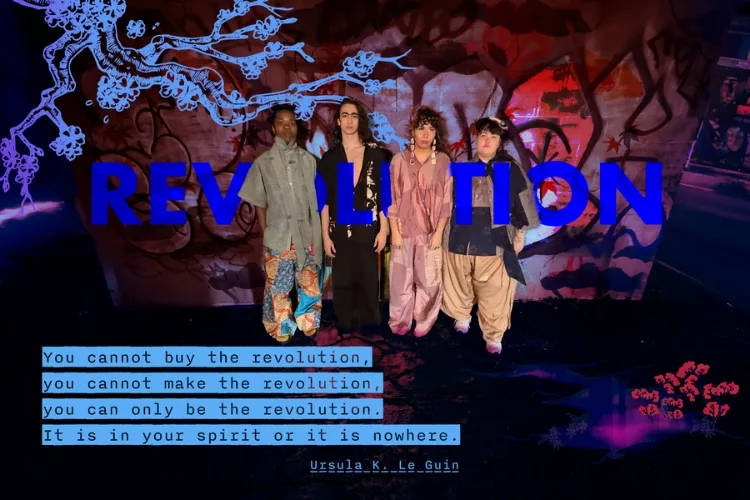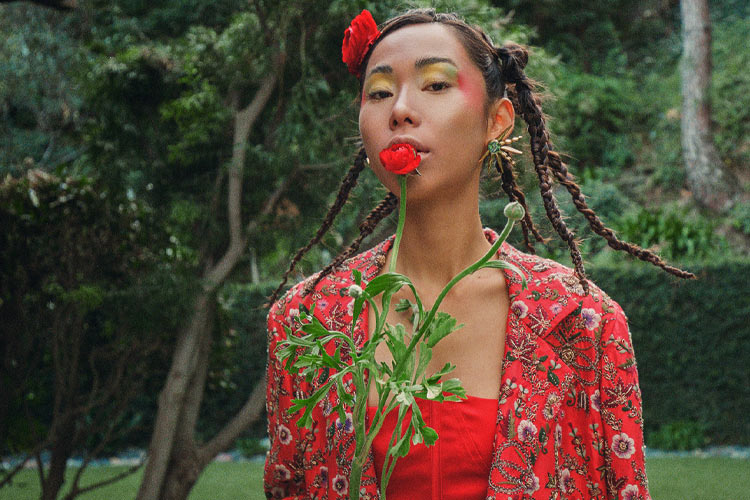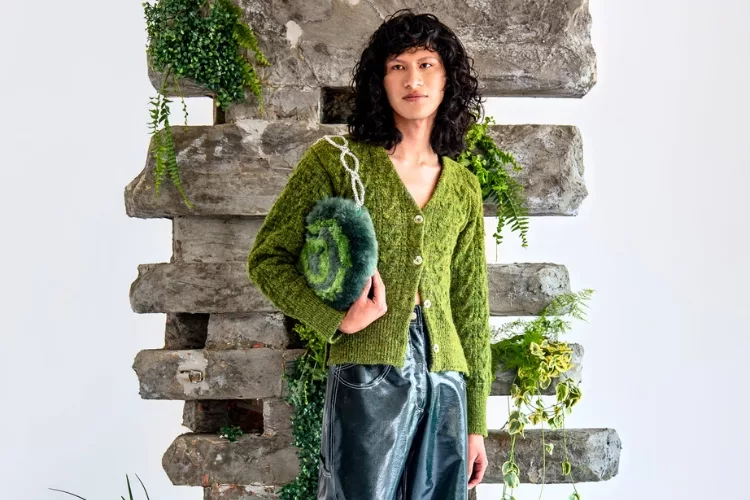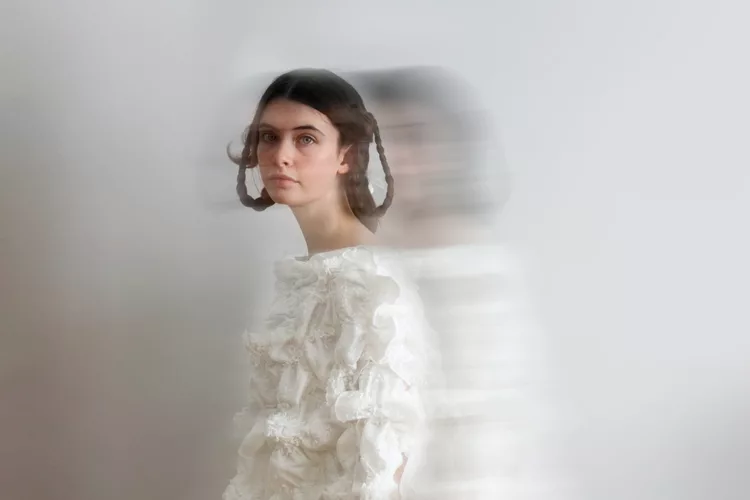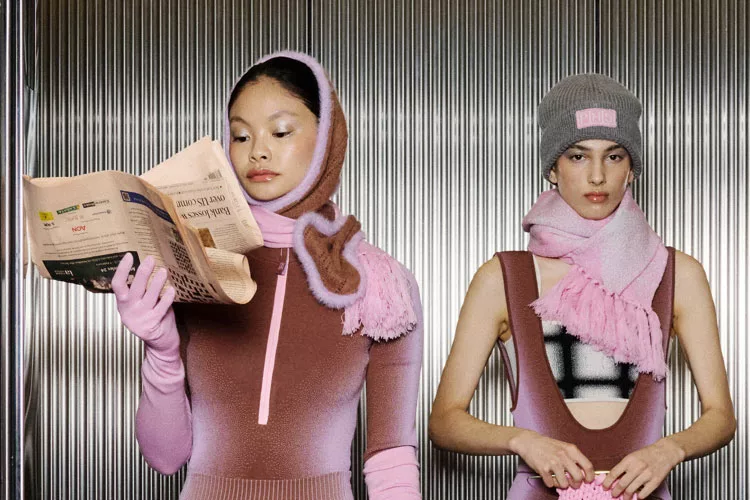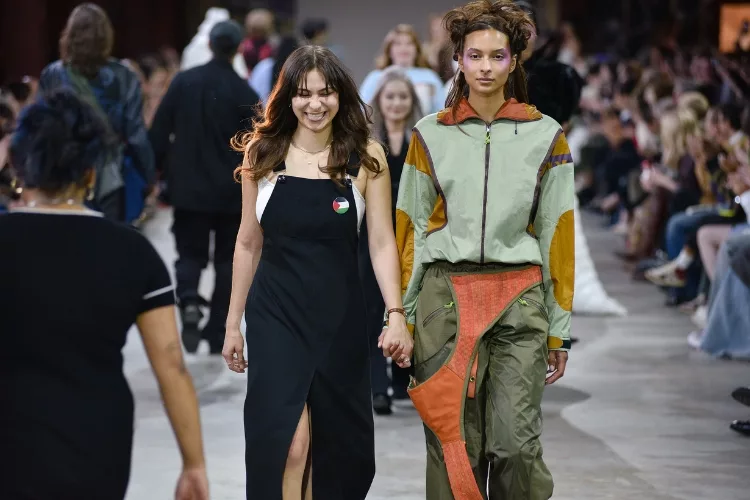
Courtesy of Pratt Institute
The energy was electric on the runway last Friday at the Powerhouse Arts. The event, simply called “The Show,” marked the 123rd annual runway presentation, showcasing 180 looks from collections by 20 soon-to-graduate designers from Pratt Institute’s BFA Fashion Design program.
The night also honored Marni’s Creative Director Francesco Risso, who received the 2024 Pratt Fashion Visionary Award for his significant contributions to the fashion world and his role in inspiring future fashion leaders. Francesco mentored the graduating class earlier in the semester, sharing with them insights and providing valuable feedback on their work.

“Francesco is someone who is very centered in his work, but it’s not about his ego, it’s not about being a star. And the fashion industry, as we know, it loves its stars and it loves a hierarchy—for better or for worse—and here’s somebody, to me, [who] is always about his work in relationship to other people, which I think is an incredibly valuable lesson for us all to think about in our daily work and practice in this industry.”
–Mark Holgate, Fashion News Director at Vogue and presenter of the award.

Emilio Pompetti received the 2024 Christopher Hunte “On Point” Award, a $10,000 prize awarded to one graduating designer for his collection. The Brooklyn native’s collection reinterprets iconic sports apparel with feminine silhouettes and artistic patterns.
The challenge for young fashion designers is how they can make their work in a way that doesn’t further harm our planet. The Fashion Industry is notoriously damaging and exploitative so –fair or not– it’s on the younger generation to do better. Below we highlight some of the Pratt Fashion ’24 cohort who recognize this and create accordingly.

Jeff Cai
I fully respect the life cycle in nature and I believe that people should enjoy every part of that process, which includes decaying.
Name of Collection: Lament of Agony
What is the inspiration or concept behind it? I believe that inevitably people get hurt in their life, both physically and mentally. Those experience might leave scars and it might not go away. But it is something that makes you unique and special. Although it hurts it may also be your most memorable experience, which is precious. I took inspiration from decaying flowers and broken butterflies as well as references to human anatomy to convey this.
How is circularity part of your ethos? OR How has your idea of “making” changed in this era of climate change?
The natural cycle of life is an important part of my concept and I have always paid a lot attention to sustainability. I absolutely hate over production and fast fashion. Therefore when I was making my collections, I tried my best not to purchase first hand material unless I have to, and I never over buy materials.
Where do you hope to be in 3 years?
My ideal plan is to work in NYC for a year after graduation, and then I am seeking for international opportunities between China and the U.S. Eventually I want to have my own brand.
Three things keeping you sane right now
My handy fashion tool set, gaming time with my friends, and the archive I have built up of fine clothes.
If you could design for anyone in the world who would it be and why? I would love to design for Alexander McQueen, even tho’ he’s no longer with us. I really appreciate his wildness and elegance in his collection. He makes wild designs but with a high standard of construction. He is also an activist for environmental protection and human right. Which I really respect because he is trying to spread the message with his work.
I also would love to work with Sara Burton, the Creative Director of Alexander McQueen after Lee. I appreciate her stunning tailoring design and I am always a huge fan of her aesthetics.
Where can we find you online? On instagram @jeff.cai00

Anna Felton
If we are to continue to appreciate and explore nature, we need to do it in a way that respects it in all aspects, whether that’s through reusing materials, incorporating only natural ones, or creating new biodegradable, eco-friendly textiles, there are ways to make fashion truly sustainable.
Name of Collection: Adaptation 2024
What is the inspiration or concept behind it? Creating functional/adaptable clothing made from reused material.
My thesis collection is made from used tents, tent floor plans, climbing rope, climbing gear, water bladders, and tent rain covers I’ve sourced from REI and friends. I also cut up and re purposed thrifted jackets, dresses, and pants/leggings, as well as sourced sustainable fabrics from Mood.
How is circularity part of your ethos? My collection is heavily based on the re-use of materials and sustainable fabrics!
Anything else? I like using unconventional materials and my love for outdoor gear allows me to approach it in a creative way. These days outerwear is made from plastic polymers and nylon which keeps it durable and long lasting, however it still creates plastic pollution from the making process to discarding. If we are to continue to appreciate and explore nature, we need to do it in a way that respects it in all aspects, whether that’s through reusing materials, incorporating only natural ones, or creating new biodegradable, eco-friendly textiles, there are ways to make fashion truly sustainable
Where can we find you online? @ele_ivav

Brendan Sheerin
How is circularity part of your ethos? OR How has your idea of “making” changed in this era of climate change?
In this collection, I focused on using exclusively natural materials, deadstock, and naturally dyed textiles. It is a very “hands on” process.
For example, a top was made from deadstock linen which I coated with beeswax by hand. Another top and skirt were made using bridal silk scraps which I dyed naturally with matter root before patching together into a textile from which the patterns were cut. All the buttons used throughout my collection by hand from copper, nickel, and brass scraps from a jewelry studio.
Where can we find you online? Brendanmsheerin.com @brendanmsheerin

Lu Luyao Tang
I have been considering creativity and “making” more carefully in this era of climate change since faced with the reality that our designs have an impact on the global scale whether it’s the garment makers overseas or people and land from the global south who bear the burden of textile waste.
Name of Collection: Forget Me Not
What is the inspiration or concept behind it?
My collection, Forget Me Not, is an exploration of sheltering the body and mind from hurt that comes with loving relationships. My designs center around garments as symbolic protection and a safe space to allow vulnerability. My metamorphosis of the vintage beekeeper’s uniform and military uniform is envisioned through the use of natural materials like cotton shirting, waxed canvas, linen, cotton-rayon, cotton silk, mercerized cotton and vintage crochet doilies. Gender fluidity and size inclusivity is also central to my design ethos, reflected in size flexible silhouettes and ironic use of culturally gendered textiles. My appreciation for handwork is also demonstrated through my hand knitted and hand finished garments.
How is circularity part of your ethos? OR How has your idea of “making” changed in this era of climate change?
I aim for longevity when I design. I believe in making well crafted garments and silhouettes that withstand the test of time and can be passed down from wearer to wearer. I also believe in making the most ethical and sustainable decisions to the best of my ability; like using natural materials over synthetic ones and sourcing material second hand whenever I can.
I also source materials locally as much as possible, and engineer zero waste and menial waste patterns when I design to reduce production waste. I have been considering creativity and “making” more carefully in this era of climate change since faced with the reality that our designs have an impact on the global scale whether it’s the garment makers overseas or people and land from the global south who bear the burden of textile waste.
My collection features two zero waste garment designs, a top and a dress, and two knitwear designs that are inherently minimal waste.
Where do you hope to be in 3 years? I want to pursue pattern making after graduation but I’m very open to whatever life brings me. I hope to be content and make positive changes within the fashion industry wherever I am.
Three things keeping you sane right now
The blooming flowers and thriving plants remind me of the power of nature and ground me in my habitat. With so much chaos in the world my crochet hooks, my instrument of making, along with students out there protesting against the genocide of the palestinian people gives me hope and keeps me sane.
If you could design for anyone in the world who would it be and why? Design is always storytelling, expression, and empowerment to me. I hope to design for the under-represented. Telling the story of diverse body types and queerness is something I hope to carry on with.
Where can we find you online?
You can find me @lucy_lu_design and @forgetmenot_bkny
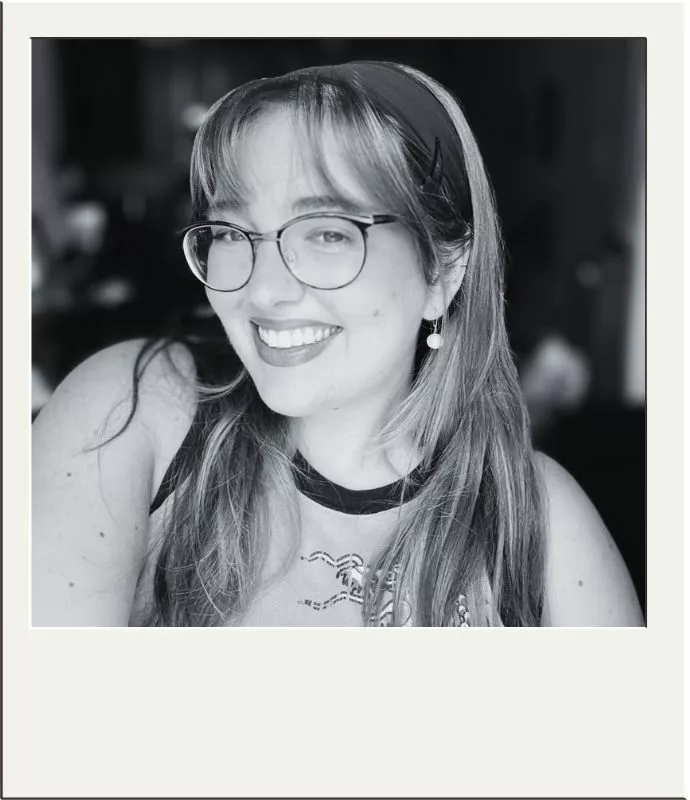
Madison Newcombe
My collection was made from about 80% found, thrifted, and up-cycled materials.
Name of Collection: “it’s not that serious”
What is the inspiration or concept behind it? My collection is based on the inferiority complex as well the good things that come with getting older and gaining new responsibilities. Responsibilities such as dressing professionally, paying rent, and finding a place to live. I also drew inspiration from how I dressed as a kid. Pulling from the bright color combinations and interesting layering but bringing it into my style now.
How is circularity part of your ethos? OR How has your idea of “making” changed in this era of climate change?
Thrifting and up-cycling are a large part of my life as well as my design ethos. I think it’s really important to try and give new life to things that already exist in an industry that’s constantly pumping out new production.
Where do you hope to be in 3 years? I hope to be part of a design team at a company that I resonate with and care about that prioritizes sustainability and circular fashion. Learning as much as I can before eventually one day starting my own brand.
Three things keeping you sane right now
My amazing friends and support system, being excited to make something new, knowing at the end of the day I’m in a career I love
If you could design for anyone in the world who would it be and why? Dauphinette! The brand does such a great job of keeping sustainability in mind throughout the different aspects of the business. I also feel like their aesthetic most similarly aligns with mine and I would be so honored and proud to be able to learn from them.
Where can we find you online? @__madijane

Malek Rasmussen
The wood from the collection was sourced roughly 20 years ago by my late grandfather who sourced it from old spruce telephone poles which he had planned to use to build his own airplane.
What is the inspiration or concept behind your collection?
My collection is focused on family tradition and playing homage to my grandfather’s love for woodcraft which he shared with me at an early age. I took many of the lessons he taught me into my thesis. The greatest lesson of all was to allow the raw beauty of the materials to shine through.
How is circularity part of your ethos? I am committed to working with what already exists. I would say 90% for my resources came from my family and friends (leather, wood) or from Pratt Institutes SOD department (yarns). The other remaining 10% I bought secondhand.
Anything else?
I would like to mention that when I was creating my garments I skipped the prototype stage of using muslins or samples. I made everything in final. I did this because I like seeing how the material acts when draping and it saved a lot of time/money from having to make the collection two times. Also cancelled out sample waste. This doesn’t mean I got everything perfect on the first try but instead I allowed the mistakes to inform the designs.
Last note. When designing my collection I wanted to make sure that the designs could fit a range of sizes rather than just sample size. I did this by having adjustable closures and panels in each garment. This way of designing has allowed me to sell my clothes to a range of customers.
Runway Photography by Fernando Colon
Courtesy of Pratt Institute
Related Articles

